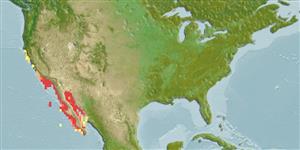Élasmobranches (requins et raies) (sharks and rays) >
Carcharhiniformes (Ground sharks) >
Triakidae (Houndsharks) > Triakinae
Etymology: Mustelus: Latin for weasel, an ancient name for sharks, possibly referring to the pointed snouts, swift movements and/or rapacious feeding behavior of smaller predatory sharks [strictly not tautonymous with Squalus mustelus Linnaeus 1758 since type was designated by the ICZN] (See ETYFish); californicus: -icus (L.), belonging to: California, referring to its common occurrence along the coast of California (USA) (See ETYFish).
More on author: Gill.
Environment: milieu / climate zone / profondeur / distribution range
Écologie
marin démersal; profondeur 0 - 200 m (Ref. 55308), usually 2 - 46 m (Ref. 55308). Subtropical; 40°N - 23°N, 126°W - 109°W (Ref. 55308)
Eastern Pacific: northern California, USA to the Gulf of California. At the southern part of its range, this species is sympatric with Mustelus lunulatus, but the two are readily distinguishable.
Length at first maturity / Taille / Poids / Âge
Maturité: Lm 78.1, range 85 - ? cm
Max length : 116 cm TL mâle / non sexé; (Ref. 244); 124.0 cm TL (female); âge max. reporté: 9 années (Ref. 6098)
A common inshore and offshore shark found on the continental shelves, and entering shallow muddy bays. Feeds mostly on crabs, including cancrids and grapsids, ghost shrimp, innkeeper (echiuroid) worms (Urechis), and small fish (herring and midshipmen, Porichthys). Viviparous (with a yolk-sac placenta), with 2 to 5 young in a litter. Utilized for human consumption.
Viviparous with a yolk-sac placenta (Ref. 244).
Compagno, L.J.V., 1984. FAO Species Catalogue. Vol. 4. Sharks of the world. An annotated and illustrated catalogue of shark species known to date. Part 2 - Carcharhiniformes. FAO Fish. Synop. 125(4/2):251-655. Rome: FAO. (Ref. 244)
Statut dans la liste rouge de l'IUCN (Ref. 130435: Version 2024-2)
Menace pour l'homme
Harmless
Utilisations par l'homme
Pêcheries: commercial; pêche sportive: oui
Outils
Articles particuliers
Télécharger en XML
Sources Internet
Estimates based on models
Preferred temperature (Réf.
123201): 15.1 - 23.3, mean 20.9 °C (based on 46 cells).
Phylogenetic diversity index (Réf.
82804): PD
50 = 0.5000 [Uniqueness, from 0.5 = low to 2.0 = high].
Bayesian length-weight: a=0.00224 (0.00104 - 0.00482), b=3.14 (2.97 - 3.31), in cm total length, based on LWR estimates for this Genus-body shape (Ref.
93245).
Niveau trophique (Réf.
69278): 3.5 ±0.2 se; based on diet studies.
Generation time: 4.4 ( na - na) years. Estimated as median ln(3)/K based on 2
growth studies.
Résilience (Réf.
120179): Très faible, temps minimum de doublement de population supérieur à 14 ans (K=0.22-0.35; tm=1.3-2.1; tmax=12; Fec=2).
Fishing Vulnerability (Ref.
59153): Moderate to high vulnerability (52 of 100).
🛈
Nutrients (Ref.
124155): Calcium = 20.7 [5.6, 105.3] mg/100g; Iron = 0.522 [0.162, 2.021] mg/100g; Protein = 21.8 [19.4, 24.1] %; Omega3 = 0.139 [0.057, 0.331] g/100g; Selenium = 42.6 [12.0, 151.0] μg/100g; VitaminA = 5.54 [1.87, 15.85] μg/100g; Zinc = 0.595 [0.263, 1.199] mg/100g (wet weight);
